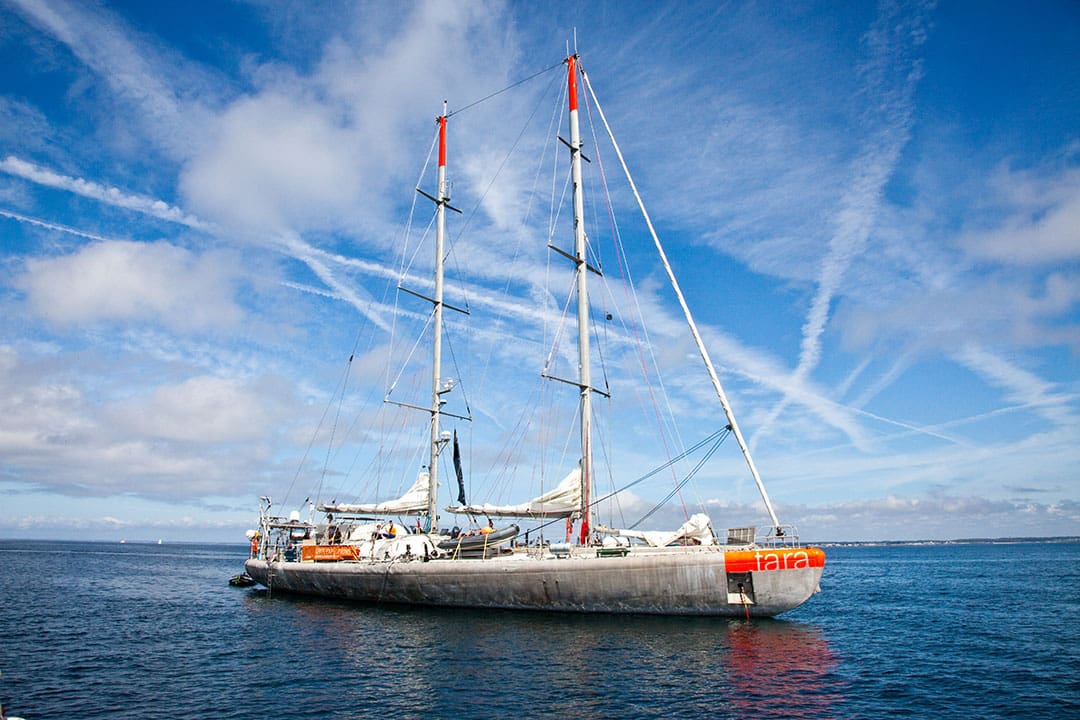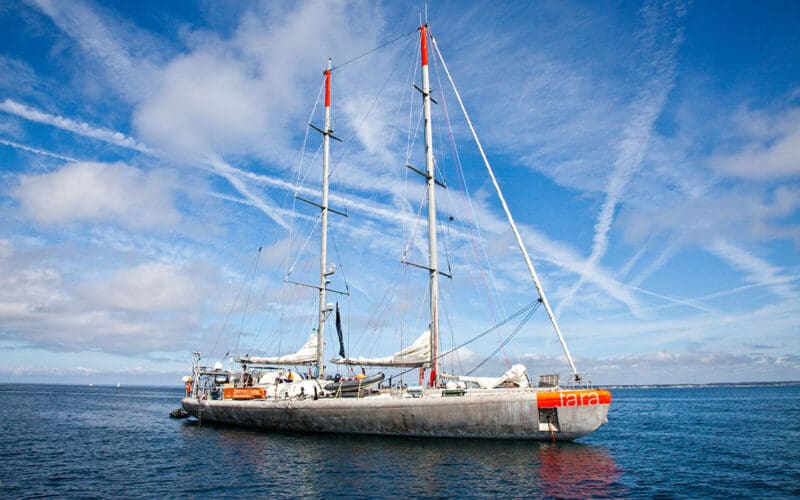
The top layer of our ocean is called the “Sunlight Zone.” At the surface and down to about 200 meters are live microscopic floating algae called “phytoplankton” that are critical to life. Voyagers on trans-ocean voyages can and do participate in the study of phytoplankton. More data is always better so data gathering by voyagers helps increase our knowledge of what’s happening with the world’s oceans. Now new gear from several companies can make gathering this data easier for voyagers.
Plankton, from the Greek word planktos meaning wanderer, defines a lifestyle rather than a specific organism, and includes all water-borne organisms that are passively driven by currents. Phytoplankton get their name because they contain chlorophyll, require sunlight to live and grow, and produce oxygen and sugars like terrestrial plants through photosynthesis.
Phytoplankton are responsible for half of the world’s oxygen production, though they account for less than 1 percent of the Earth’s photosynthetic biomass. Though rough analyses of the ocean surface can be done by satellite, boats collecting samples are the only means to study them in detail. While the U.S. government owns and operates a fleet of ocean research vessels, the vastness of the effort of identification leaves a big need for independent groups to participate.
Recently I was invited to an online lecture by the Carnegie Institute for Science, “Exploring the ocean multiverse with Tara Oceans.” I assumed this was a person’s name, but “Tara Oceans” was a two-and-a-half-year expedition undertaken in 2009 by the French sailboat Tara through the Mediterranean, Red Sea, Indian and Pacific Oceans, and the Panama Canal to the Atlantic. The expedition took water samples and collected plankton to understand their relationship to their environment.
Tara is a 118-foot (36-meter) aluminum-hulled schooner designed and built in France in 1989 and originally sailed by Jean-Louis Étienne, a medical explorer, under the name Antarctica. In 1999 Sir Peter Blake, New Zealand America’s Cup and Whitbread sailor, bought the schooner and renamed her Seamaster. He took her on an expedition to spread environmental awareness, focusing particularly on water. Blake was shot and killed in 2001 by pirates while sailing Seamaster on the Amazon River. Following Blake’s death, the yacht was bought by French designer Agnès Troublé, known as agnès b., and her son Etienne Bourgois and renamed Tara after the plantation in Gone with the Wind.
Tara collects plankton and other microorganisms by various sampling methods, including lowering bottles to gather whole ocean water, nets to collect organisms and particles, and a continuous sampling system consisting of a pump and filters which allows scientists to sample anytime and analyze through optics (photography). Phytoplankton are at the bottom of the aquatic food chain, forming the basis for productive and healthy marine ecosystems. Knowing where and how much phytoplankton exist in the ocean aids in understanding the entire marine food-web. Phytoplankton also remove CO2 from both the water and the atmosphere, an important consideration for addressing climate change.
During the original Tara Oceans expedition the schooner had to slow to a speed of 0.6 to 1.3 knots for sampling, depending on conditions. For the Tara Pacific Expedition, undertaken in 2016 to 2018, new sampling devices were developed to collect seawater and organisms while sailing at a maximum of nine knots, the average cruising speed of Tara and a large step forward in making such expeditions more efficient.
Deep ocean racers have been crossing the surface for more than 150 years, often with sponsorship that could pay for sampling equipment, but the need to slow or stop made them unwilling to participate, as in “You either focus on the race or you gather environmental data.” During the 2022-2023 Ocean Race, with the organizers dedicated to sustainability and ocean stewardship, the American-flagged vessel 11th Hour Racing Team sampled enroute from Brazil to Newport, Rhode Island, and still won the race. This is a big deal particularly because 11th Hour is an International Monohull Open Class Association (IMOCA) 60, part of a new class in the race. The IMOCA 60s have limitations on length and draft and are allowed up to five “appendages” which on these incredibly fast (up to 35 knots downwind) boats includes two foils.
11th Hour collected eDNA (environmental DNA) using a kit put together at New Zealand’s Cawthron Institute. According to NOAA, eDNA is genetic material shed by organisms in the water column. The kit combines a user-friendly OceanPack monitoring system created by SubCtech for yachts to gather water samples while underway, with an eDNA filter capsule designed by Smith-Root to simplify the capture and preservation of eDNA, and effective and inexpensive gene sequencing technology from Illumina.
The work done by Tara and traditional oceanographic research vessels involves making direct visual observations or physically capturing species, which can be slow, expensive, and harmful to marine life. Providing eDNA equipment to the thousands of sport boats plying the oceans makes sense as a way to track endangered species and monitor microbes and pathogens, and boaters have a keen sense of the ocean environment and desire to protect it. Scientists processing eDNA from samples of mucus, feces, or tissue particles make discoveries about marine life without coming into direct contact with the organisms. From the 11th Hour samples the research team extracted 4.7 million DNA sequences and identified 11,000 species ranging from Argentina anchovies at risk from overfishing to tiny copepods at the base of the marine food chain.
Like other places in life, boating is where odd twists occur. Another IMOCA 60 entrant in The Ocean Race 2022-2023, Biotherm IMOCA, teamed up with Tara Ocean Foundation to study phytoplankton in areas where Tara couldn’t, particularly in the Southern Ocean. They installed a state-of-the-art automated microscope called an Imaging FlowCytobot (IFCB) that takes small samples of water and captures high resolution images of microscopic particles. Biotherm was nominated in 2023 for World Sailing’s 11th Hour Racing Sustainability Award.
But in coastal waters you don’t even need big sailboats to collect samples. Scientists from NOAA’s Pacific Islands Fisheries Science Center send autonomous surface vehicles called Wave Gliders around the Hawaiian Islands to study phytoplankton distribution and gather information on key ocean conditions such as temperature, oxygen, and salinity to see how climate change may be impacting local fisheries.
Wave Gliders, made by Liquid Robotics, capture the up and down motion of ocean waves and transform it into forward motion. A surface-going float is attached to a sub by an umbilical cord. As waves move the float up and down, wings on the sub rise and fall propelling the vehicle forward. A solar electric thruster can add extra speed and they travel at several knots in ideal conditions. The float is covered in solar panels and has everything needed for a self-contained data collection system; computer, communication equipment, battery packs. It navigates its course, makes adjustments to avoid ships or objects, carries sensors and collection equipment and can stay out for up to three months. For this study, three Wave Gliders travel in tandem at 1.5, three, and six kilometers from shore taking measurements down to 150 meters.
With such a huge area to cover, what about analyzing the ocean surface from above? Satellites have been gathering data on phytoplankton since the 1990s and NASA will soon launch a new one called PACE (Plankton, Aerosol, Cloud, and ocean Ecosystem). Large amounts of phytoplankton change water color. A “hyperspectral” Ocean Color Instrument on PACE will analyze more than 100 different wavelengths of light, making it possible to collate phytoplankton species by color and separate them from other particles. It won’t be able to collect individuals but knowing what phytoplankton are where over time can indicate changes in the ocean and help scientists track why and how they happen. n
Contributing editor Ann Hoffner and husband Tom Bailey cruised aboard their Peterson 44, Oddly Enough. They’re now based in Sorrento, Maine.

